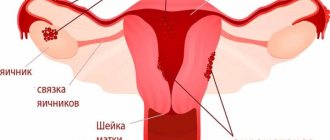Hormones are regulators of all systems and organs of the body. In women, the functional state of the endocrine glands primarily determines reproductive health. All hormones influence each other, so a failure in the production of one of them leads to the development of other hormonal disorders. Therefore, it is so important to identify and correct the disease in a timely manner. First of all, disruption of the production of sex hormones affects the menstrual cycle. Endocrine diseases often cannot be completely cured, but an adequate quality of life can be restored and normal well-being can be restored with the help of medications.
There are usually two reasons for disruption of hormone production: congenital disorders that are established in utero and appear at a certain stage of life, or acquired. The second category includes, in particular, the consequences of taking pharmaceutical hormonal drugs.
The possibility of complete restoration of the endocrine system and other body systems depends on the severity of the disorders and their causes. At the moment, for almost all hormonal diseases, there are effective treatment regimens that allow you to get rid of unpleasant symptoms - but before selecting treatment, you will have to undergo a full diagnosis and establish the cause of the disorder.
Norm and pathology
Hormonal imbalance can occur at any age. According to statistics, teenage girls and women in the premenopausal period most often experience problems. This is understandable - at these moments serious changes occur in the endocrine and reproductive systems.
Hormones are produced in the endocrine glands: pituitary gland, hypothalamus, thyroid gland, adrenal glands, ovaries, pancreas. Let's look at the main hormones that affect reproductive function:
- Estrogens are a whole group of biologically active substances that are produced in large quantities in the first phase of the menstrual cycle.
- Prolactin is responsible for breastfeeding, its concentration increases with the appearance of milk. Prolactin reduces the concentration of estrogen and slows down ovulation - thus, it protects the body from pregnancy while breastfeeding.
- Follicle-stimulating hormone - responsible for the growth of follicles in the ovaries. Produced at the beginning of the menstrual cycle.
- Luteinizing hormone - increases the rate of estrogen synthesis and is responsible for the release of a mature egg from the follicle capsule.
- Progesterone - produced during ovulation, is responsible for the formation of the corpus luteum. Its concentration increases significantly during pregnancy.
- Testosterone - despite the fact that it is a male sex hormone, it is also present in the female body. Performs an important function during pregnancy - it stimulates the enlargement of the mammary glands.
Together, these substances regulate the menstrual cycle and affect the possibility of conception. Together with them, but to a lesser extent, reproductive health is also regulated by other hormones of the endocrine system - they are in close relationship. As a rule, a disruption in the production of one hormone provokes secondary changes, and as a result, a complex hormonal imbalance occurs.
The functional state of the reproductive system directly affects the production of hormones. For example, in adulthood, when a woman’s supply of eggs runs out, a restructuring of the hormonal system occurs - the ability to bear children disappears, and menstruation disappears. During puberty, on the contrary, the body's systems prepare to perform the reproductive function.
During such periods, the line between normal and pathological is arbitrary - unpleasant symptoms may appear, which will disappear after some time. If you have doubts about your own health, it is better to consult a specialist. Between the ages of 18 and 45, hormonal levels are considered fairly stable. If unpleasant symptoms appear during this period, a visit to the doctor is definitely required.
At CELT you can consult an endocrinologist.
- Initial consultation – 3,500
- Repeated consultation – 2,300
Make an appointment
Symptoms in adults and adolescents
The symptoms of the disorder depend on the age of the patient and the cause of the disease. During reproductive age, women complain of the following:
- increased pain during menstruation;
- menstrual disorder in the form of delay or complete cessation of menstruation;
- increased PMS phenomena;
- decreased libido;
- increased hair growth on the body and face;
- the presence of acne, constant foci of inflammation on the skin;
- sleep disorders;
- Strong headache;
- frequent mood changes for no apparent reason;
- irritability, increased aggressiveness directed towards others;
- The amount of vaginal lubrication decreases, which is why a woman feels discomfort during sexual intercourse.
This situation requires contacting a doctor and correcting the condition. In adolescent patients, this failure has other manifestations. This is due to the beginning of the establishment of hormonal levels characteristic of an adult woman. It manifests itself with the following symptoms:
- lack of hair growth in the pubis and armpits;
- the rate of formation of mammary glands is reduced;
- Menarche did not occur before age 17;
- Irregularity of the cycle persists for more than a year after the first menstruation.
A sharp weight gain or a pronounced lack of weight in a girl is often a sign of hormonal imbalance.
Causes of pathology
Globally, all causes are divided into congenital and acquired during life.
The most common causes of hormonal imbalance in women:
- Consequences of taking oral contraceptives. Controversy continues around these drugs. Most gynecologists are confident in their safety, but only if the appointment is carried out after consultation and under the supervision of a specialist. Most often, violations appear after incorrect withdrawal of pills.
- Consequences of taking emergency contraception. These drugs greatly change hormonal levels, resulting in menstrual irregularities, which do not always recover on their own.
- Uncontrolled use of drugs containing hormones without appropriate prescription. Unfortunately, some patients neglect to consult a specialist and start taking medications purchased without a prescription. The consequences are the development of hormonal disorders.
- Diseases of the endocrine system. They lead to a failure in the production of essential hormones.
- Physiological changes during puberty and adulthood. Against the background of hormonal changes, hidden pathologies often appear.
- Abortion. This is a strong stress for the body, in which physiological restructuring has begun, and it is immediately interrupted. The body does not always manage to restore the natural functioning of the endocrine glands.
- Prolonged stress is also one of the most common causes. It has been proven that stress, anxiety and depression are associated with a decrease in the production of oxytocin, which, in turn, affects the synthesis of prolactin.
Pregnancy is also considered a hormonal imbalance - but it is physiological. If the pregnancy proceeds normally from the point of view of the vital signs of the mother and child, then various unpleasant symptoms are allowed - they are not dangerous to the health of the mother and child.
Hormonal imbalance in women
Hormones are an important component in a woman’s body, which greatly influences the functioning of its individual systems and as a whole. If a hormonal imbalance occurs in women, this is accompanied by poor health, menstrual irregularities and even infertility. Moreover, these changes in the body can occur in women of any age - adolescence, adulthood (20-40 years) and during menopause. Signs of hormonal imbalance in women often occur before menstruation.
Hormonal imbalance in women: symptoms
If we are talking about monthly hormonal imbalances, then the symptoms are general and manifest themselves in:
- insomnia;
- increased irritability;
- swelling of the whole body and face;
- weakness and forgetfulness;
- soreness of the mammary glands;
- frequent headaches;
- increased appetite, etc.
Hormonal imbalance - symptoms in women after 30 are more pronounced:
- Extreme fatigue.
The woman constantly feels tired, exhausted, and sleepy. This is due to the excess levels of progesterone and TSH in her body. - Poor quality sleep
. Sleep disturbances manifest themselves in long attempts to fall asleep, and the sleep itself becomes short-term, without deep immersion. As a result, the woman is unable to fully recover overnight and this affects her health. - Menstrual irregularities.
With a healthy hormonal background, the menstrual cycle is 21-35 days. Any changes over 7 days give reason to consider the cycle irregular. For women over 40 years of age, such fluctuations should lead them to think about the possible onset of menopause. Other situations indicate pathological processes in the reproductive system. - Digestive disorders.
Disturbances in the functioning of the thyroid gland lead to poor quality food processing, causing diarrhea or constipation. - Changes in breast shape.
Due to an increase in estrogen, the mammary glands swell, and due to a decrease, on the contrary, a loss of density occurs. Swelling is often accompanied by the formation of lumps and cysts. - Baldness
. Dihydrotestosterone is a hormone that, under certain conditions, destroys hair follicles. There are other hormones that promote severe hair loss (for example, progesterone, prolactin, etc.). - Severe and frequent headaches
. The same estrogen can influence headaches - increase or decrease them. - Obesity.
Jumps in cortisol, insulin and serotonin slow down metabolism and increase cravings for starchy and sweet foods. - Numerous rashes
on the face, back, chest. The increased functioning of the sebaceous glands causes blockage of the pores, resulting in a lot of rashes and irritation on the skin. - Deterioration of memory
and concentration. A woman becomes distracted when problems with the thyroid gland arise. - Sudden mood swings.
Thanks to norepinephrine, dopamine and serotonin, a woman can experience sudden mood swings that are noticeable even to others. - Inability to get pregnant
. When the hormone progesterone is in short supply in the body, a woman cannot become pregnant. This is an important sign of hormonal imbalance.
In addition, hormonal imbalance in women, the symptoms of which are quite serious, is accompanied by vaginal dryness. The reason for this phenomenon is a decreased level of estrogen.
Hormonal imbalance in women: causes
When hormonal imbalances occur, strong changes occur in a woman’s body, which do not have the best effect on her health. There are a number of reasons that contribute to these changes that you need to be aware of.
The main causes of hormonal imbalance:
- pathologies of internal organs of an infectious and non-infectious nature;
- use of certain medications;
- genetic predisposition;
- weak immunity;
- strong feelings, being under constant stress, excessive physical activity;
- dieting, vitamin deficiency, excess weight, etc.
Hormonal imbalance in women, the symptoms and treatment of which should be carried out strictly according to the recommendations of the attending physician, does not occur without reason. There are always reasons that lead to changes in hormone levels in the body.
How to treat hormonal imbalance in women?
An experienced specialist begins treatment of hormonal imbalances by identifying the reasons that led to this. To identify, the doctor prescribes an examination:
- clinical blood test;
- STD testing;
- Ultrasound of internal organs;
- laboratory blood tests for hormones, etc.
The results obtained will help the doctor see the real picture of the changes occurring in the female body. Tests will show which hormones have a negative effect on the body.
Hormonal imbalance in women - step-by-step treatment:
- Taking tests, in-depth examination and identifying the true causes of disorders in the body.
- Taking medications prescribed by the doctor. Medicines help normalize the level of hormones produced.
- Inhibitory therapy. Necessary for increased hormone production.
- Compliance with special nutrition rules.
- Compliance with the rest-work regime.
In some situations, the question of how to restore hormonal imbalance in women can even be solved by surgical intervention.
In general, treatment for hormonal imbalance depends on the age of the patient and may include the following:
- hormone replacement therapy – used during menopause;
- taking oral contraceptives - if a woman has an irregular cycle during puberty;
- stimulation of ovulation – if a woman experiences hormonal infertility.
Hormonal disorders are also restored by taking vitamins, minerals, dietary supplements, antipsychotics, physiotherapy and therapeutic exercise. If the situation requires it, the endocrinologist will issue a referral for consultation with specialists.
Symptoms of pathology
Symptoms of hormonal imbalance may vary depending on the nature of the disorder, in particular:
- changes in the duration and regularity of the menstrual cycle;
- intermenstrual bleeding;
- hair growth disorder;
- nipple discharge;
- emotional lability;
- change in sexual activity;
- change in appetite;
- weight disorders.
The appearance of these symptoms is a reason to make an appointment with an endocrinologist.
Treatment
To correct hormonal levels, women are prescribed hormone therapy under the strict supervision of a doctor. In addition, the following measures are taken to eliminate the causes of the disease:
- treatment of inflammatory pathologies of the genital area and STDs;
- therapy of extragenital diseases of organs and systems that affect hormonal regulation;
- conducting rational psychotherapy.
If conservative treatment is ineffective, surgical interventions are used to correct the condition. Women have hormone-dependent tumors removed and other necessary operations performed.
In addition to drug therapy, it is important for patients to adhere to the recommended regimen of activity and rest. They need feasible physical activity and sufficient sleep. It is necessary to adhere to proper nutrition.
It is important for women to consult a doctor in a timely manner and not attribute the symptoms of the disease to excessive workload and fatigue. It is important not to self-medicate, but to consult a medical doctor.
Pregnancy and hormone imbalance
Symptoms of hormonal imbalance during pregnancy are subtle. As a rule, the doctor notices them first. Therefore, it is important to regularly visit a gynecologist and not refuse preventive examinations.
There are manifestations that are difficult to notice immediately:
- change in endometrial thickness;
- development of fibroids;
- pathology of follicle maturation;
- disruption of hormone production: lack of progesterone and estrogen, excess testosterone.
After conception, a whole cascade of changes begins in the body. With sufficient medical control, almost all pregnancy pathologies can be corrected and do not lead to serious consequences.
Treatment of hormonal disorders
Before starting treatment, it is necessary to determine the cause that caused the hormonal imbalance. To do this, when visiting a doctor, the necessary examination is carried out. Based on the results obtained, the doctor can fully draw up a complete picture of the disease and decide which active substances are causing the malfunction in the body.
The recommended treatment for hormonal disorders involves taking special medications that normalize the level of active substances produced. In case of increased hormone production, doctors prescribe inhibitory therapy, which suppresses the increased release of substances in the body. Specialists also carry out nutritional adjustments and help develop an optimal rest and work schedule.
Diagnostics
Diagnostics includes both instrumental examinations and laboratory tests. The examination begins with a visit to a therapist or a specialist - a gynecologist or endocrinologist. Often the pathology is complex, so treatment will have to be done by several doctors.
Instrumental diagnostics includes:
- Ultrasound of the thyroid gland and pelvic organs, as well as mammary glands. This study is carried out for any complaints with symptoms of hormonal imbalance. In most cases, ultrasound can reveal which gland the pathology is associated with.
- MRI may be required if anatomical changes are detected and further diagnostics are required.
Laboratory tests include blood tests for hormones. The attending physician decides which hormones need to be determined, based on the nature of the complaints and examination data. As a rule, there are no problems with diagnostics - modern analysis methods are quite accurate.
Causes
The causes of hormonal disorders are most often a strong psycho-emotional shock or genetic predisposition. Under the influence of stress or a panic attack, a person experiences a release of the hormone cortisol, and this condition is accompanied by sudden changes in blood pressure and an emotional outburst. Among the most common causes are also gynecological diseases, mental stress, a surge in sex hormones during puberty, and regular use of alcohol and drugs.
Hormonal disorders in women are caused by gynecological diseases, artificial hormones and phytohormones, strong physical activity, and birth control pills. In addition, this may be the period of menopause, pregnancy, abortion, lack of estrogen or progesterone, or sexually transmitted infections. Men are characterized by the appearance of endocrine problems due to a lack of testosterone and androgens, with irregular work schedules or obesity. Another cause of hormonal imbalance is iron deficiency anemia, abdominal trauma, impaired metabolism and kidney failure. Lack of proper rest, eating foods with hormones and poor diet are of great importance.
Methods of diagnosis, treatment and prevention
To diagnose an imbalance, laboratory tests for hormones are prescribed, which can determine the level of corticosteroids, androgens and estrogens. Additional tests may include ultrasound of internal organs and tests for infectious diseases.
The course of treatment usually includes the following activities:
- taking medications;
- hormone therapy;
- physiotherapeutic procedures;
- surgical intervention;
- physiotherapy.
To prevent endocrine disorders, it is recommended to adhere to a healthy lifestyle, play sports, swim, avoid stressful situations and eat right. The diet should include foods rich in vitamins and microelements, as well as follow a sleep and rest schedule.
Any hormonal disorder can cause serious illness and malfunction of the reproductive system. To avoid this, it is important to know the typical signs of disorders and not ignore the body’s requests for help.
Types of violations
Hormonal disorders are divided into male and female. For guys, the formation of hormonal levels occurs closer to the age of 19, when puberty ends. By the age of 40, hormone levels decrease and this happens against the background of a toxic effect on the body, a tight work schedule, overwork and genital tract infections.
Women typically develop premenstrual syndrome a week before menstruation. During this period, swelling of the mammary glands, cramps and headaches may bother you. The hormone estradiol, which is the most active estrogen, contributes to the appearance of these signs. Another type of female disorder is amenorrhea and menopause. Amenorrhea can be primary or secondary. It usually appears due to disease of the ovaries, uterus or thyroid gland. Menopause appears closer to 50 years of age and indicates a decrease in hormone levels or disorders of the reproductive system.








